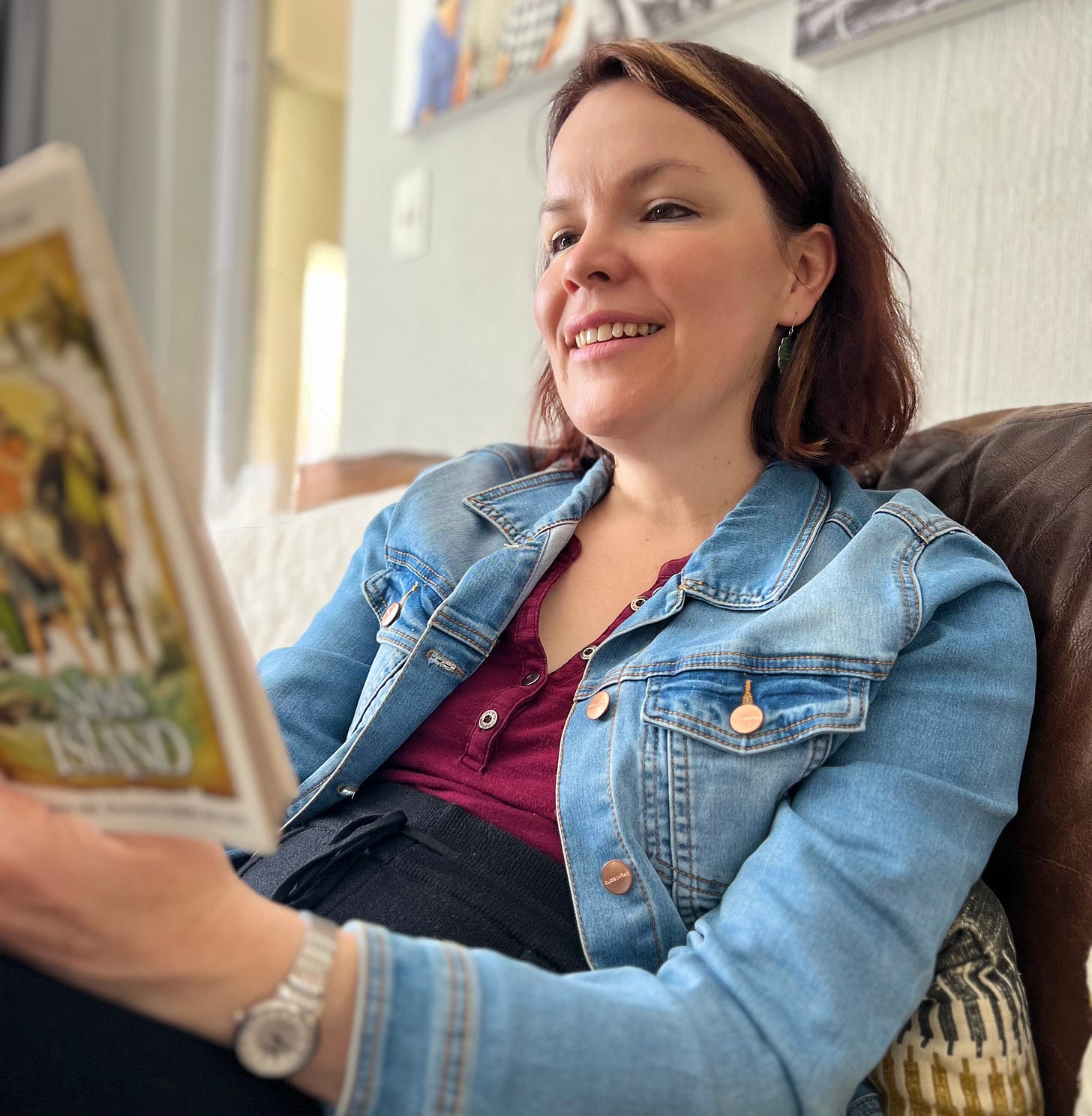Read-Alouds, Red Cappuccinos, and a Calendar Full of Stories
A cozy homeschool habit, a rainbow of stickers, and a quiet way to collect learning and memories.
We’ve been talking a lot lately about using AI in our homeschooling in our AI Diaries Series — and honestly, we love the techie stuff. But today, I’m switching gears. This post is about one of our more analogue practices, and one of the most magical parts of our homeschool days: reading aloud.
I’ll also be sharing the sweet, simple way we track our read-alouds — with a wall calendar and a bunch of happy little stickers.
This isn’t a “you should read aloud to your kids” kind of post. I’m guessing you’ve got enough shoulds coming at ya. This is more of a “psst, here’s a little secret” kind of post. Because reading aloud is one of the most fun and no-prep ways we learn and connect as a family.
And when we started keeping a little record of it, it quietly turned into a kind of game… and, unexpectedly, a treasure trove of memories.
Why we’re still reading aloud (even though the kids can read)
We’ve read aloud with our kids long past the age they’ve been able to read independently, and there’s a reason for that. Actually, lots of reasons.
According to Jim Trelease’s Read-Aloud Handbook, reading aloud builds vocabulary, focus, comprehension, and connection — long after kids can read independently. Trelease argues that reading aloud is one of the most important things you can do for a child’s future reading ability.
Sarah Mackenzie’s book, The Read-Aloud Family was one of my first and favorite books I read about homeschooling. And her Read Aloud Podcast continues to be one of my go-to listens on my podcast player.
Add that to using Julie Bogart’s Brave Writer Literature Singles for Language Arts, and I think you could safely say that our family is “drinking the read-aloud Koolaid”!
Reading aloud benefits all of us, adults included. It also gives us a shared language — inside jokes, references, emotional memories — that stick around long after the book is closed.
Oh, and this doesn’t have to be a long and laborious affair. Just ten minutes a day can unlock many of these benefits. So when we only manage a short session, I remind myself: that counts.
As a homeschooling family, reading aloud is our go-to strategy — especially if we’re in a bit of a funk, or have a few minutes before we need to leave for music lessons, or if the Math concept of the day has left a few brains smoking 🤯.
But it’s not just for the tricky times, it also gives a beautiful rhythm to our days — that kind of loose structure that feels safe and comforting, but leaves some space for magic and sparkles!
Bedtime Read-Aloud
We read to our kids every night before bed — so we’re pretty much guaranteed at least one read-aloud sesh per day. Although, if you look closely, you might notice in our calendar that we had one day where we didn’t read aloud. That was because we opted to stay up for a movie night instead!
Garren and I alternate bedtime read-alouds. We each read from our own book, so the boys get two ongoing storylines. One night it might be Harry Potter and the Deathly Hallows by J.K. Rowling with me, and the next night, Kay’s Anatomy by Adam Kay with Dad.1
By the way, Kay’s Anatomy has been laugh-out-loud funny. It’s a human anatomy book written for those who love toilet humor — a demographic my kids certainly fall into. I’ll admit that I’ve found myself eavesdropping on this one — giggling at the jokes and chiming in with occasional pronunciation guidance.2
And yes, you may notice that that’s a non-fiction book. Bedtime read-aloud doesn’t necessarily have to mean bedtime story, as in fiction.
We’ve had brilliant success with reading non-fiction aloud — The Story of the World (Vol. 1: Ancient Times) by Susan Wise Bauer was a bedtime favorite that’s sparked some great historical rabbit trails. Garren got to read that one, so I’ve booked Volume 2: The Middle Ages to read next!
A Midday Ritual (Reddies + Reading)
Our daytime read-alouds have lately taken on a bit of flair: the boys have started making themselves a “reddie” — a frothy red cappuccino made from rooibos tea — before we settle into a read-aloud session.
I have an Americano and read in between sips.
They have their hot drinks at the coffee table, and when they’re finished3, they come and cuddle next to me on the couch.
In general, yes, it is idyllic. Are there days when the cappuccino-making process is messy? Yes. Are there days when we don’t do the whole reddie ritual? Sure. And days where we just read a page and then get interrupted by a delivery, or worse, a cold call. Argh! Shoulda put that thing on silent!
Either way: “5 stars. Would highly recommend.”
Now, you might be nodding along, excited about adding some more reading aloud to your week, or already reading aloud regularly.
Want to keep track of all that reading aloud? In a fun and simple way? Here’s how we’ve done it.
How we track our read-alouds (with stickers!)
You certainly don’t have to keep track of your read-alouds, but I’ve found it’s great to have something to show for your efforts.
I’ve tried a few different ways to track our reading:
Everyday Reading’s Printable Tracker — a beautiful bookshelf illustration where you fill in the names of books on the spines. We loved it for picture books. But for longer chapter books, we struggled — you only get the payoff when you finish the book. Plus, my kids aren’t big into colouring.
A Goodreads Account — as previously stated, I love myself some tech, but this wasn’t visual enough for the whole family. And also, it’s taken me a while to get used to keeping an online reading log!4
The Rainbow Calendar Log — I once tried writing the book title each day we read, in a different colour for each book. But writing “Harry Potter and the Order of the Phoenix” over and over? My hand protested.
So then… we discovered the sticker calendar.
Here's how it works:
We use a regular wall calendar.
When we start a new book, I write the title and author on the day we begin.
That book gets assigned a sticker colour — we’ve got a stash of little smiley face stickers.
Each day we read that book, we add a sticker in its colour.
I also happened to have a leftover set of race-themed stickers — flash stickers for the start of a book, and checkered flags for the finish.
I also had a pack of those motivational stickers that teachers put in their kids’ workbooks. We now use those to rate our books!
This sticker system has been one of those small ideas that brings outsized joy and visibility to something we value deeply. It’s also one of the only “trackers” I’ve been able to stick with consistently.
And I think the magic is in its playfulness. There’s no pressure to finish a book quickly. No need to write tiny words repeatedly. Just a colorful reminder: we showed up to storytime today.
Here’s what our 2025 calendar looks like so far:
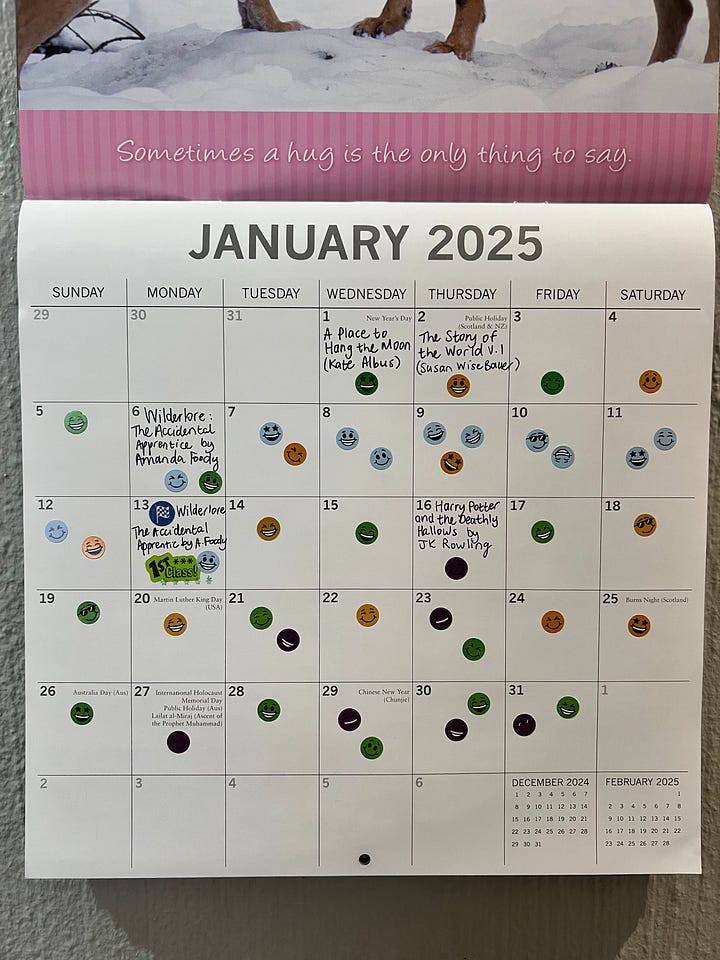
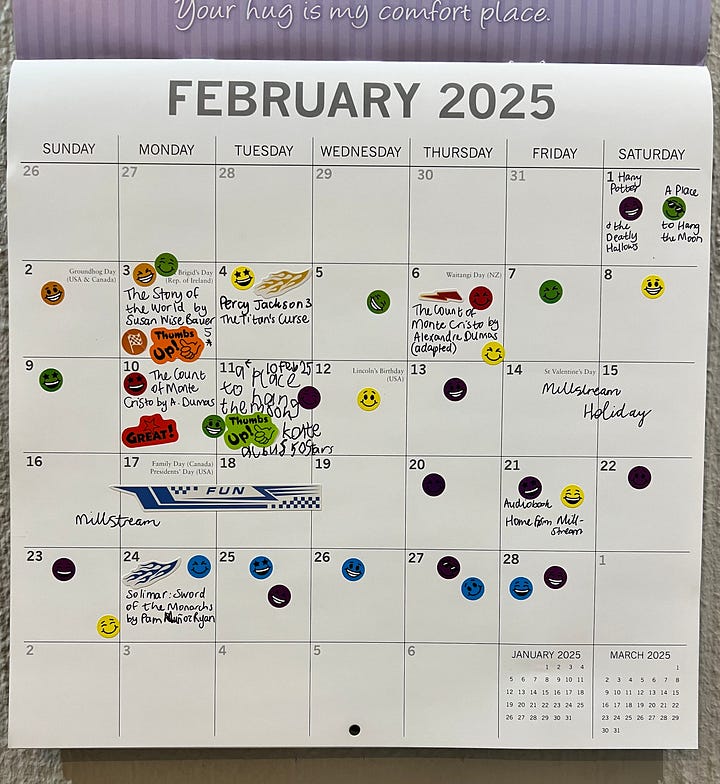
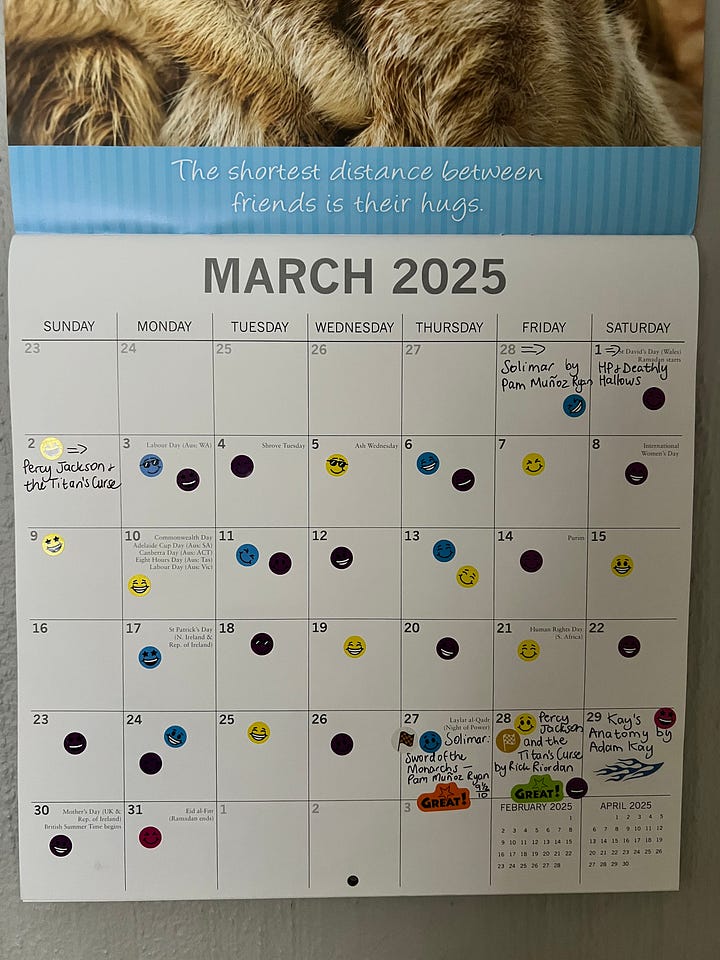
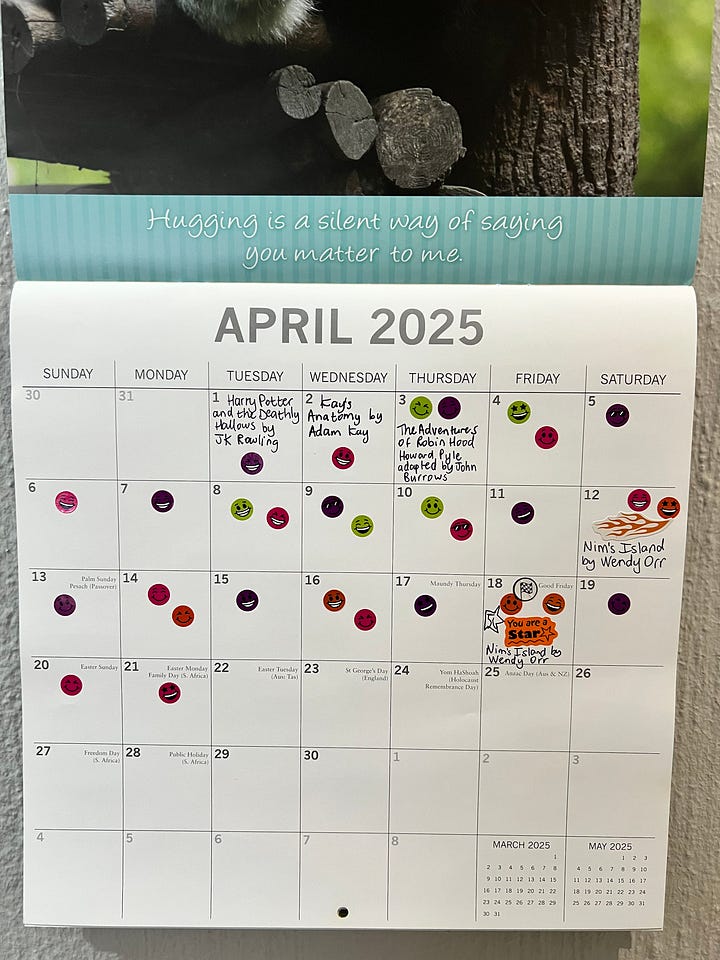
A few favourites
Recently, we read Nim’s Island by Wendy Orr as part of our Brave Writer Language Arts curriculum. It was such a hit that we read half the book in one day — a morning binge session followed by a nighttime finish.
Wilderlore: The Accidental Apprentice got the same treatment. “Read more, read more!” the boys chorused — which, honestly, is the best kind of parenting problem to have.
What this turns into
This sticker system is more than a log. It’s a collection — one of Kieran Egan’s5 learning tools. It turns something fleeting (a ten-minute storytime) into something lasting and visible. And it invites us to look back and say, “Oh wow — look how much we’ve read!”
It’s a little ritual. A little game. A little celebration. And a way to make stories part of the architecture of our days.
Want to play along?
If reading aloud sounds good to you (even in the “I’d love to but I don’t know where to start” kind of way), here’s my gentle invitation to you:
Try marking each day you read aloud — even if it’s just a few minutes — in a way that feels fun to your people. Not because you “should,” but because it can be one of the easiest, most meaningful educational and connection-rich activities you do all day.
If you’re into stickers? Grab a calendar and start your own colorful story tracker. But go with what whatever feels fun for your an your family — a checklist, or stamps, or a big poster, or an digital system.
Make it visible. Make it light. And most of all, make it yours.
Let us know in the comments how you track your reading.
A few years back, we tried a rather odd system where we alternated chapters of the same book. The result? Confused storylines and patchy memories of Beatrix the Bold and Chitty Chitty Bang Bang Flies Again. We’ve since learned our lesson — alternating books makes much more sense!
I’ve been nicknamed “The Peanut Gallery” and I’m wondering whether my input is appreciated…! ;)
I do cry over spilled milk, especially if it’s on my couch!
I am doing better this year with tracking my own reading on Goodreads, and I do even add our read-aloud books to my personal tally!
I use Kieran Egan’s philosophy all the time as part of a Learning in Depth Cohort I’m co-mentoring. I’m hoping to write more about his amazing ideas in the future.




